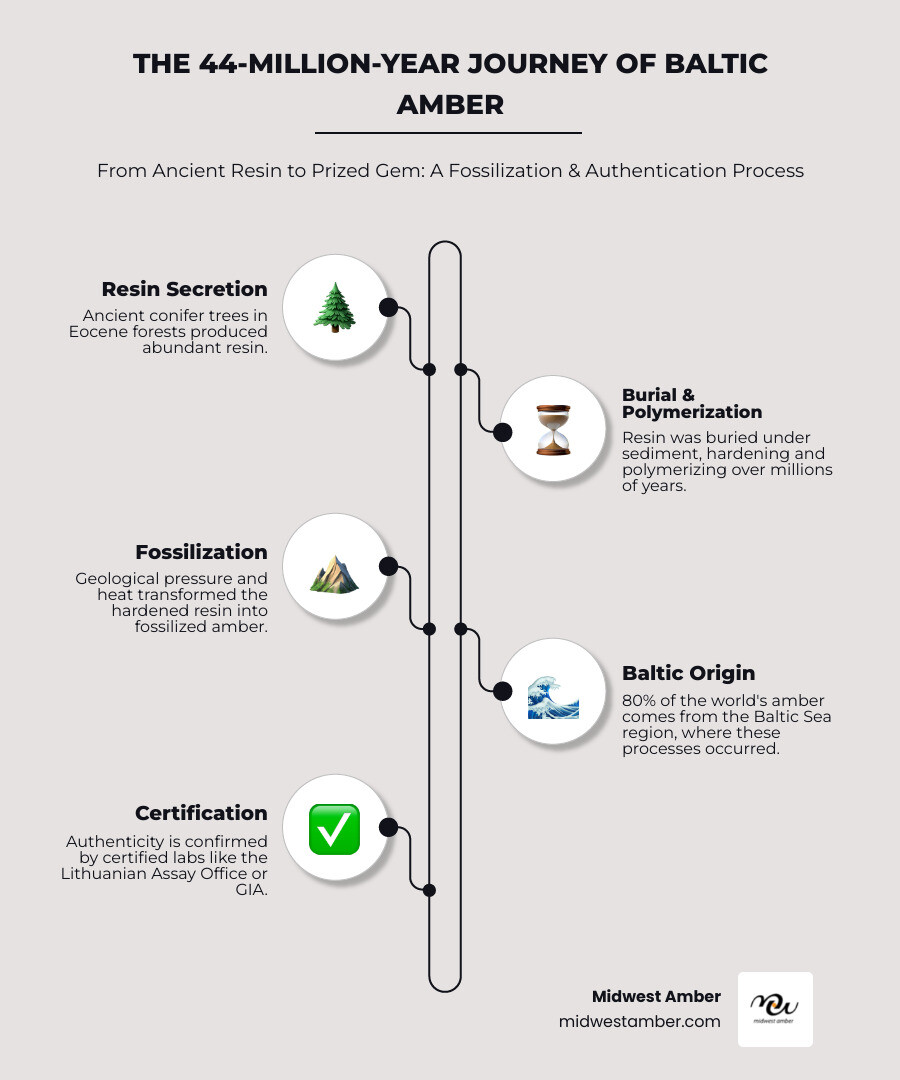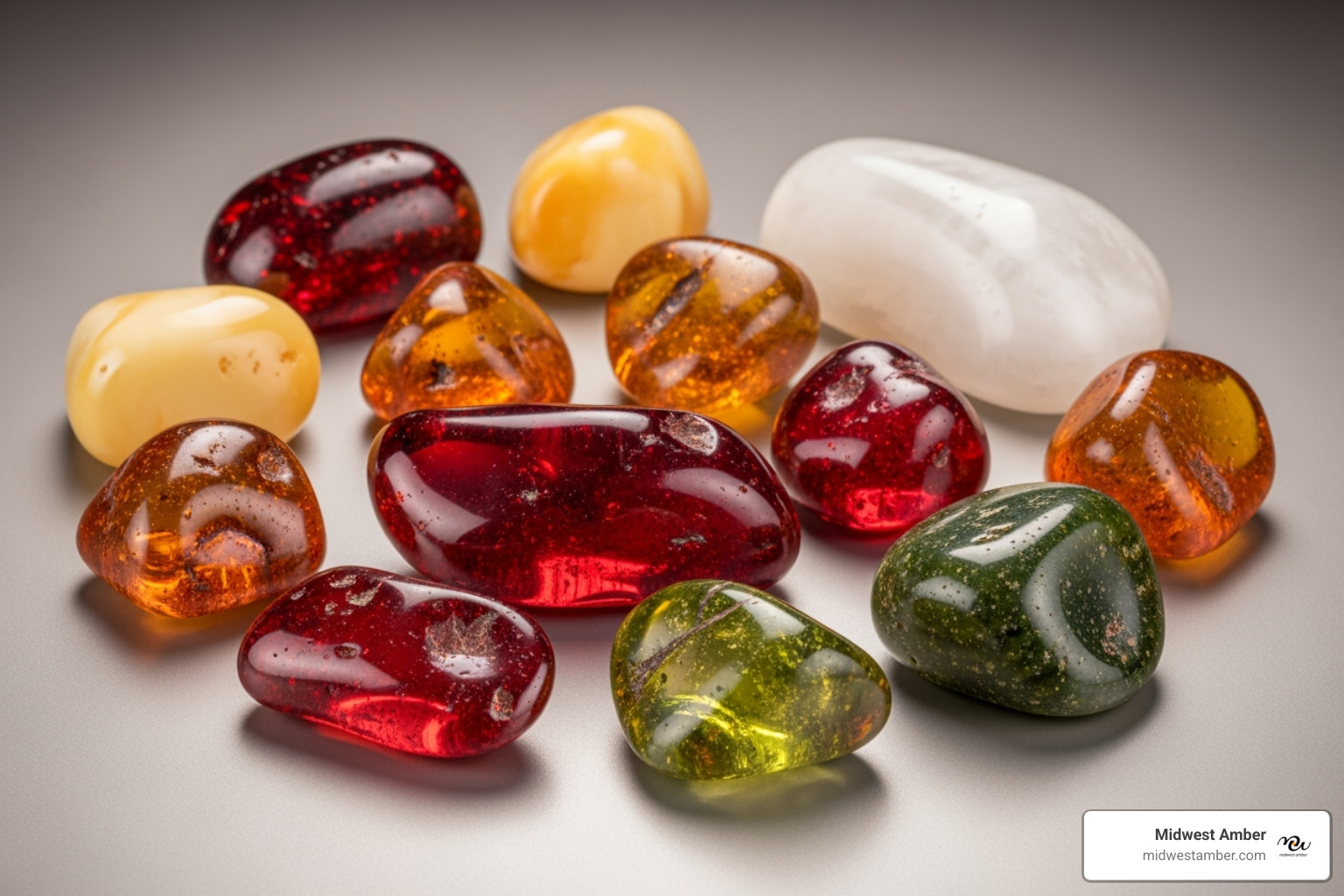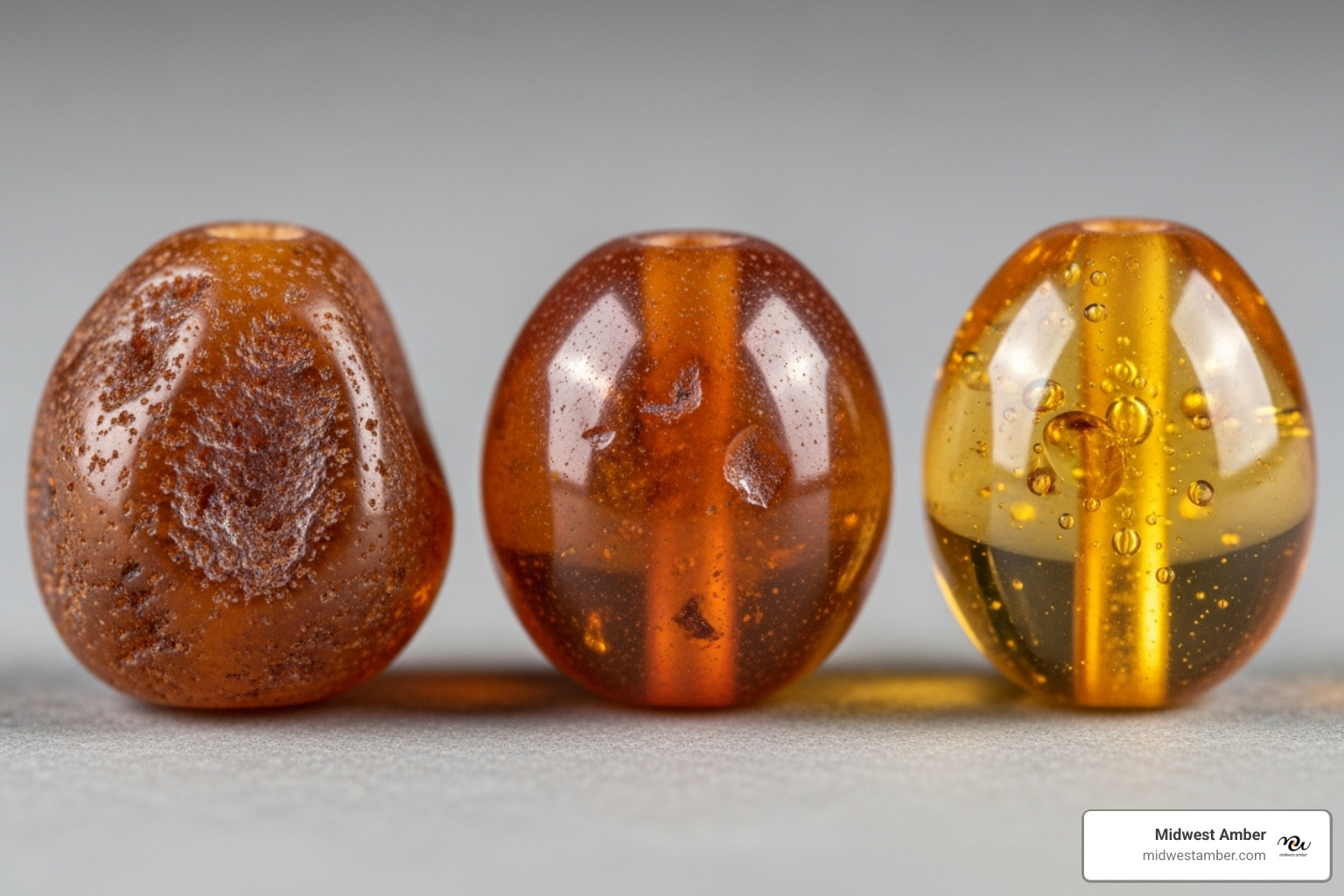Why Authentic Baltic Amber Matters in Today's Market
Certified Baltic amber represents one of nature's most fascinating treasures—a 44-million-year-old fossilized tree resin that has captivated humans since the Stone Age. Yet in today's marketplace, distinguishing genuine Baltic amber from clever imitations has become increasingly challenging.
Quick Authentication Guide for Certified Baltic Amber:
- Origin: Must come from Baltic Sea region (80% of world's amber deposits)
- Age: 44-60 million years old fossilized conifer resin
- Certification: Look for certificates from Lithuanian Assay Office or GIA
- Simple Tests: Floats in salt water, smells like pine when heated, becomes electrically charged when rubbed
- Key Component: Contains 3-8% succinic acid (highest concentration in outer cortex)
The stakes are high, as amber has been prized for millennia, from Roman amulets to protective talismans. Today's market, however, is flooded with copal (young resin), plastic, and glass imitations that can fool even experienced buyers.
Understanding what makes Baltic amber unique is about more than avoiding fakes. This ancient resin, containing over 40 compounds, has been used in folk medicine for centuries. The highest quality amber comes from the Baltic region, where unique climate conditions 44 million years ago led to the creation of the fossilized resin we treasure today.
I'm Gabriel Ciupek, President of Midwest Amber, Inc. With years of experience in the Baltic amber industry, I've helped countless customers steer authentication and quality. I know that proper certification is the best way to protect buyers from costly mistakes.

What Makes Baltic Amber Unique? From Ancient Forests to Prized Gem
Here at Midwest Amber, we believe that understanding the journey of Baltic amber is key to appreciating its true value. This section explores the origins, characteristics, and rich history that make Baltic amber a treasured natural gem, far more than just a beautiful adornment.
The 44-Million-Year-Old Story of Amber Formation
Around 44 million years ago, during the Eocene epoch, vast coniferous forests covered what is now Northern Europe. Intense climate changes caused these ancient trees to exude massive amounts of protective resin, a sticky substance destined for an extraordinary change.

Over millions of years, buried deep within the earth under immense pressure and heat, this resin underwent polymerization and oxidation. The volatile compounds evaporated, and the resin hardened into the stable fossil we know as amber. Amber is not a stone but an organic gem, a testament to prehistoric life.
The vast majority of the world's amber, approximately 80%, is found in the Baltic Sea region. Countries like Poland and Lithuania are home to the largest known deposits, making Baltic amber truly unique and globally significant.
A Rainbow of Colors and Prehistoric Inclusions
One of the most captivating aspects of Baltic amber is its incredible diversity in color. While often associated with warm, honeyed tones, amber comes in a stunning spectrum, each shade telling its own story.

Yellow is the most common color, making up about 70% of all amber, though only about 10% is truly transparent. Beyond yellow, we find:
- White amber: Very rare (1-2%), its milky appearance caused by microscopic air bubbles.
- Natural red amber: Especially rare (0.5%), these deep tones are highly prized.
- Greenish amber: Also rare, accounting for about 2% of all colors.
- Blue amber: The rarest and most valuable shade (0.2%), its hue often appears under specific light.
- Black amber: Frequent (15%), its dark color is due to impurities like tree bark.
What truly makes amber a "window to the past" are its inclusions. As the sticky resin flowed, it often trapped insects (86.7%), arachnids (11.6%), and plant matter, preserving them perfectly for millions of years. Holding a piece of amber is like holding a piece of history in your hand.
The Historical Journey of "Northern Gold"
The allure of Baltic amber is not a modern phenomenon. For millennia, this fossilized resin has been coveted and traded, earning it the moniker "Northern Gold."
Evidence suggests amber was used for adornments as early as the Paleolithic Age. Ancient civilizations, from the Greeks to the Romans, highly prized it for its beauty and perceived mystical properties. The legendary "Amber Road" was an ancient trade route that transported amber from the Baltic coast to the Roman Empire. Historical records show that in the time of Emperor Nero, the value of a small amber statuette could exceed that of a healthy slave. Beyond jewelry, it was used in religious artifacts and even as incense, a testament to its enduring appeal.
The Ultimate Guide to Identifying Genuine and Certified Baltic Amber
After helping thousands of customers over our 20+ years in business, I've learned that knowing how to spot authentic amber is essential. The market is flooded with clever fakes, and even experienced buyers can be fooled. Let me share the insider knowledge that will protect your investment and ensure you're getting genuine certified Baltic amber.
Simple At-Home Tests to Spot a Fake
While professional certification offers complete peace of mind, you can perform several reliable tests at home using amber's unique properties.
- Saltwater Flotation Test: Genuine Baltic amber is light and will float in saltwater (mix 2-3 tbsp of salt into a glass of water). Most fakes, including glass and plastic, will sink.
- Hot Needle Test: Use caution and test a tiny, hidden spot. Heat a needle until red and gently touch it to the amber. Real amber releases a distinctive pine resin scent. Plastic fakes produce awful chemical smells and melt instantly.
- Gentle Friction Test: If you're nervous about the hot needle, rub the amber vigorously with a soft cloth for a minute. The warmth from friction alone will release the same subtle pine fragrance.
- UV Light Test: Shine an ultraviolet light on your amber. It should reveal a telltale blue or greenish fluorescence—a secret signature that most fakes can't replicate.
- Electrostatic Charge Test: Rub your amber with a soft cloth for 30-60 seconds. Real amber builds up static electricity and will attract small pieces of paper or hair. The ancient Greeks called amber "electron" for this reason.
- Hardness Test: With a Mohs scale rating of 2-2.5, genuine amber can be scratched by a fingernail. Be extremely careful, as this test can damage your piece.
Understanding What "Certified Baltic Amber" Truly Means
While home tests are useful, nothing beats the security of certified Baltic amber. Certification isn't just a piece of paper—it's your guarantee of authenticity.
Certified amber undergoes rigorous scientific testing at respected institutions like the Gemological Institute of America (GIA) or the Lithuanian Assay Office. These labs verify that the item is genuine fossilized resin, not copal, plastic, or glass. They also confirm it originates from the Baltic Sea region, ensuring it has the unique geological age and succinic acid content that makes it so special. For items like baby teething necklaces, certification also includes safety compliance with standards like Europe's EN71-1.
Your certificate will have a unique serial number, serving as official proof of authenticity. At Midwest Amber, our direct relationships with suppliers and two decades of experience mean we stand behind every piece of certified Baltic amber we offer.
Common Fakes and How to Avoid Them
Knowledge is your best weapon against amber imposters. Here are the most common fakes:
- Copal: This is young tree resin, only thousands of years old. While it may pass some tests, it often feels slightly sticky and contains modern insects, not prehistoric ones.
- Glass: Heavy and cold to the touch, glass sinks in saltwater, produces no scent when heated, and creates no static charge.
- Plastic: Fakes made from celluloid or phenolic resins sink in saltwater, produce terrible chemical odors when heated, and feel unnaturally uniform.
- Pressed Amber (Ambroid): This is made from real amber pieces fused together. While it passes basic tests, it often has swirly, unnatural patterns and elongated air bubbles from the compression process.
The secret to avoiding fakes is to combine multiple tests. Genuine certified Baltic amber will pass every authentic test consistently. If a price seems too good to be true, trust your instincts. When in doubt, always choose certified pieces from reputable dealers.
The Science and Lore Behind Amber's Healing Properties
For thousands of years, people have believed that Baltic amber holds special healing powers. From ancient physicians to modern parents, this "Gold of the North" has captured imaginations. Let's explore both the science and the traditions surrounding amber's therapeutic reputation.
Succinic Acid: The "Magic" Ingredient?
The secret behind Baltic amber's healing reputation lies in a remarkable natural compound called succinic acid. This isn't just folklore—it's real chemistry that makes certified Baltic amber unique.

Baltic amber contains an impressive 3-8% concentration of succinic acid, with the highest levels found in the cortex, or the stone's outer rough layer.
This isn't new-age thinking. The renowned bacteriologist Robert Koch, a Nobel Prize winner, confirmed that this compound has positive effects on the human body, strengthening immunity and improving energy processes without the risk of harmful buildup.
Today, succinic acid is recognized for its anti-inflammatory properties and its ability to help balance the body's natural processes. When you hold a piece of raw amber, you're holding millions of years of concentrated natural medicine.
For those curious to dive deeper, you can explore More on Amber Benefits on our blog.
Amber for Teething: Fact vs. Folk Tradition
In many European villages, it's common to see babies wearing amber necklaces—a tradition stretching back centuries, especially in Lithuania and Poland. The theory behind amber teething necklaces is simple. When worn against a baby's warm skin, the amber is thought to gradually release tiny amounts of succinic acid. This natural compound is then absorbed through the skin, where it may work as a gentle anti-inflammatory agent to soothe swollen, painful gums.
European grandmothers have sworn by this naturopathic remedy for generations. The appeal is its gentle, non-toxic approach, offering comfort without medications. Many parents report their babies seem calmer when wearing amber, though experiences vary.
Important Safety Precautions for Amber Jewelry
While amber's potential benefits are exciting, safety is paramount. At Midwest Amber, we've spent over 20 years perfecting our safety standards for parents' peace of mind.
Here's what every parent needs to know:
- Choking and strangulation risks are the primary concerns. Quality amber necklaces feature individual knots between each bead, so if the necklace breaks, only one bead comes loose.
- Look for breakaway clasps that pop open under pressure, preventing strangulation if the necklace gets caught.
- Adult supervision is absolutely required whenever a child wears amber jewelry. Never leave babies or toddlers alone with any type of necklace.
- The golden rule is to remove amber jewelry for sleep and unsupervised play. Some parents wrap the necklace around a baby's ankle under clothing during naps to maintain skin contact while eliminating neck risks.
With proper precautions and quality jewelry, families can explore this ancient tradition with confidence.
Choosing and Caring for Your Baltic Amber Jewelry
Now that you understand the beauty and potential benefits of certified Baltic amber, let's explore how to choose the perfect piece and keep it looking stunning for years to come. The right choice depends on your personal preferences and intended use.
Raw, Burnished, or Polished: What's the Difference?
When browsing our collection, you'll notice that Baltic amber comes in three distinct finishes, each with its own unique appeal.

- Raw Amber: This is amber in its natural, untouched state. Its rough, matte surface has an irregular texture, and the outer cortex remains fully exposed. Since this layer contains the highest concentration of succinic acid, many choose raw amber for its maximum therapeutic potential.
- Burnished Amber: This is the perfect middle ground. A gentle tumbling process gives these beads a smoother, slightly waxy feel that's comfortable against the skin, yet the pores remain open enough to potentially allow for the transfer of succinic acid.
- Polished Amber: This finish showcases the gem's visual splendor. The high-polish creates a smooth, lustrous surface that brings out amber's vibrant colors. While beautiful, the polishing process closes the amber's pores, which some believe may limit the transfer of succinic acid.
Your choice depends on what matters most: the rustic appeal of raw, the balanced comfort of burnished, or the striking beauty of polished amber.
A Guide to Amber Jewelry Care
Taking proper care of your Baltic amber is simple but requires gentle attention to maintain its natural beauty.
- Cleaning: Use only a soft cloth with lukewarm water and mild soap. Gently wipe each bead, rinse thoroughly, and pat dry immediately. Let it air dry completely before storing.
- Storage: Keep your amber in a soft pouch or a separate compartment in a jewelry box to prevent it from being scratched by other items. Avoid direct sunlight and extreme temperature changes.
- Chemical Avoidance: Always remove your jewelry before applying perfumes, hairspray, or lotions. Keep it away from household cleaners and chlorinated water from pools or hot tubs.
- Gentle Handling: Amber is an organic gem and can chip or break if dropped on hard surfaces. Remove your jewelry before bathing, swimming, or exercising to protect both the amber and its cord or chain.
With these simple practices, your certified Baltic amber will radiate its warm, ancient glow for years to come.
Frequently Asked Questions about Certified Baltic Amber
After two decades in the amber business, we've heard just about every question you can imagine! Here are the most common ones, with answers based on our experience helping thousands of customers.
Is more expensive amber better?
Not necessarily. A higher price tag doesn't automatically mean better quality or authenticity. Several factors influence amber's price:
- Size, Clarity, and Rarity: Larger, clearer pieces are rarer and cost more. Color rarity also dramatically affects value—blue amber (0.2% of all amber) is far more expensive than common yellow varieties.
- Inclusions: A perfectly preserved prehistoric insect can make one piece worth many times more than a similar piece without inclusions.
- Craftsmanship: Hand-carved pieces or intricate settings require skilled artistry, which is reflected in the price.
Price doesn't guarantee authenticity. We've seen expensive fakes and reasonably priced genuine pieces. That's why we always emphasize looking for certified Baltic amber from a trusted source rather than judging by price alone.
Does the color of amber affect its properties?
No, the color of amber does not affect its therapeutic properties. The succinic acid content remains consistent regardless of color, with the highest concentration always found in the outer cortex (the rough, outer layer). Color variations are caused by other factors:
- Microscopic air bubbles create the milky appearance in white amber.
- Natural plant matter and other debris create darker shades.
When it comes to therapeutic properties, the origin (Baltic) matters far more than the color. Your certified Baltic amber has the same potential benefits whether it's pale honey, rich cherry, or rare blue.
Can I wear my amber jewelry in water?
We always tell our customers: when in doubt, take it off. While amber survived millions of years underground, modern water activities pose challenges.
- Protecting the Amber: Chlorinated pool water, hot tub chemicals, and even soaps can dull amber's natural luster over time.
- Protecting the Cord: Water weakens silk or cotton cords, making them more likely to break. Metal components can also tarnish or corrode.
To keep your certified Baltic amber looking its best, simply slip it off before swimming, showering, or soaking in a tub. It's a small step that will preserve its beauty for years.
Conclusion: Accept the Timeless Beauty of Authentic Amber
In a marketplace flooded with imitations, authentic Baltic amber stands as nature's most remarkable treasure. You now have the tools to protect yourself, from the simple saltwater test that reveals amber's lightness to the hot needle test that releases its distinctive pine scent. These are your first line of defense against the fakes that flood today's market.
However, as we've learned in our 20+ years at Midwest Amber, nothing replaces proper certification. A certificate from the Lithuanian Assay Office or GIA is your guarantee that you are investing in genuine Baltic amber, complete with its precious 3-8% succinic acid content and authentic 44-million-year heritage.
Owning certified Baltic amber connects you to something extraordinary—a tangible piece of natural history that has captivated humans since the Stone Age. At Midwest Amber, we've built our reputation on one promise: every piece we offer is handcrafted from 100% natural, ethically sourced Baltic amber from Poland and Lithuania. We stand behind our certified quality because you deserve the real thing.
Your journey with authentic amber begins now. We invite you to explore our full collection of certified Baltic amber and find your own piece of "Northern Gold." When you're holding a piece of history that has survived millennia, why settle for anything less than authentic?




Leave a comment
This site is protected by hCaptcha and the hCaptcha Privacy Policy and Terms of Service apply.